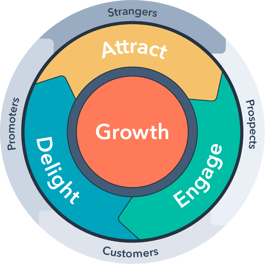Turning Friction into The Force that Grows Your Business
Revenue Operations Strategy
You’ve likely heard that RevOps is taking the B2B world by storm as businesses hire revenue operations managers or analysts. But what are Revenue Operations (fondly referred to as RevOps) really?
Driven by changes in the market and buyers' access to information, RevOps is an operations strategy implemented by B2B companies that points all teams towards one goal: Revenue.
A RevOps strategy aligns your processes to create efficiencies so that your business can keep up with modern buyers and thrive in our fast-paced world. RevOps applies force to your flywheel by streamlining your operations and aligning teams to deliver a superior customer experience and drive revenue.

Force Vs. Friction
Before we dive in let’s define what Force and Friction are:
Simply put, force makes the flywheel spin faster and friction slows the flywheel down.

The Flywheel is a model adapted by HubSpot to explain the momentum you gain when you align your entire organization around delivering a remarkable customer experience. - HubSpot
Let’s say you are a Software as a Service (SaaS) company who wants to generate more traffic to your webpage. You might start a newsletter featuring snippets of your webpage content with Calls to Action (CTAs) encouraging people to visit the page to see the rest of the content. This process would be applying force.
Then, let’s say that your company’s sales team uses a different chat platform than your marketing team. And the customer service staff uses pen and paper checklists to track tasks while your sales team uses project planning software to keep things going.
These departmental differences create siloes because your sales, marketing and customer service teams don’t have systems that speak to each other making hand-offs clunky and information gets lost. This is friction making your daily operations inefficient.
It may seem obvious what direction you’d want your business to go, but everything applied in balance is really the best strategy. But can friction be applied to create growth?
Keeping Your Flywheel from Flying Away
I know what you’re thinking: “You just told me that friction is going to slow everything down in a fast-paced industry. Why would I want to create friction?”
It seems crazy but stick with me here.
Let’s take our fictional SaaS business from above. You want to generate more website traffic and you’ve crafted your newsletter and email campaign to include CTAs to get those clicks.
You send your email to every one of your contacts and do your best to get that email into as many inboxes as possible. You press send and lean back in your chair; a job well done.
Or is it?
Applying that force may seem like the best choice but the reality is that you’ve sent your email to many contacts who the content may not be relevant to. This leads to unopened emails getting you no clicks or contacts who may not care to go to your website because they are already a client.
By assessing the buyers journey and looking at your personas you’ll be able to send your email to those contacts who will benefit from your newsletter increasing click rate and conversions. You’ll bring in more leads and gain customers.
By adding a step, you apply friction creating an intentional process that reveals more about your potential customers and gets information into the right hands. This way your goal of increasing website traffic is really about driving revenue.
Friction can be a powerful tool if applied well. Applying force with intentional friction creates a balance keeping your flywheel from flying away.
Interested in learning more? You can always reach out and chat with us.
.png)